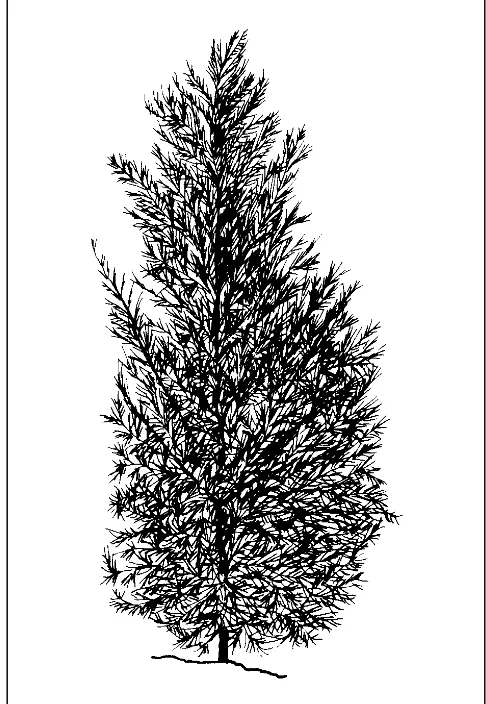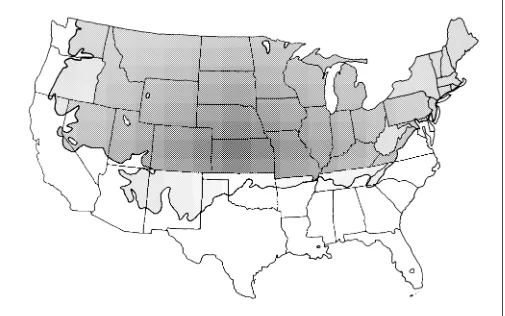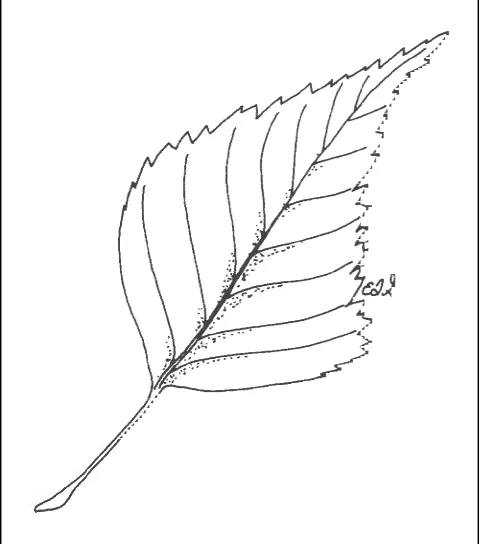Fact Sheet ST-98 November 1993
Betula pendula ‘Youngii’
Figure 1.Middle-aged ‘Youngii’ European Birch.
‘Youngii’ European Birch
1Edward F. Gilman and Dennis G. Watson2
INTRODUCTION
Youngs Weeping European Birch is graceful, weeping ornamental with wonderful yellow fall color but is susceptible to fatal attacks of bronze birch borer (Fig. 1). The leaves are often browned by birch leaf miner. When grown, plan to provide the necessary insect control and provide the necessary cultural conditions for best growth. It grows moderately with a variable height depending on how it was trained. Some specimens appear sloppy, others more tailored. Lawn grasses grow fairly well in its light shade. A moist soil and a regular fertilization program plus watering in dry weather are suggested. Although popular, the tree requires more care and spraying than other ornamental trees. Not a low maintenance tree. Maintaining a good mulch around the root zone is helpful for best growth.
GENERAL INFORMATION
Scientific name:Betula pendula‘Youngii’
Pronunciation:BET-yoo-luh PEND-yoo-luh
Common name(s):‘Youngii’ European Birch
Family:Betulaceae
USDA hardiness zones:3 through 6 (Fig. 2)
Origin:not native to North America
Uses:near a deck or patio; shade tree; specimen
Availability:generally available in many areas within its hardiness range
DESCRIPTION
Height:12 to 20 feet
Spread:15 to 25 feet
Crown uniformity: irregular outline or silhouette
1. This document is adapted from Fact Sheet ST-98, a series of the Environmental Horticulture Department, Florida Cooperative Extension Service, Institute of Food and Agricultural Sciences, University of Florida. Publication date: November 1993.
Betula pendula ‘Youngii’ -- ‘Youngii’ European Birch Page 2
Crown shape:weeping
Figure 2.Shaded area represents potential planting range.
Crown density:moderate
Growth rate:slow
Texture:fine
Foliage
Leaf arrangement:alternate (Fig. 3)
Leaf type:simple
Leaf margin:double serrate
Leaf shape:ovate; rhomboid
Leaf venation:pinnate
Leaf type and persistence:deciduous
Leaf blade length:2 to 4 inches; less than 2 inches
Leaf color:green
Fall color:yellow
Fall characteristic: showy
Flower
Flower color:brown
Flower characteristics:showy; spring flowering
Fruit
Fruit shape:elongated
Fruit length: 1 to 3 inches; .5 to 1 inch
Fruit covering:dry or hard
Fruit color: brown
Fruit characteristics: attracts birds; inconspicuous and not showy; no significant litter problem
Trunk and Branches
Trunk/bark/branches: droop as the tree grows, and will require pruning for vehicular or pedestrian
clearance beneath the canopy; routinely grown with, or trainable to be grown with, multiple trunks; not particularly showy; tree wants to grow with several trunks but can be trained to grow with a single trunk; no thorns
Pruning requirement: requires pruning to develop strong structure
Breakage:resistant
Current year twig color:brown
Betula pendula ‘Youngii’ -- ‘Youngii’ European Birch Page 3
Culture
Figure 3.Foliage of ‘Youngii’ European Birch.
Light requirement: tree grows in full sun
Soil tolerances:clay; loam; sand; acidic; well-drained
Drought tolerance:moderate
Aerosol salt tolerance: moderate
Soil salt tolerance:moderate
Other
Roots: surface roots are usually not a problem
Winter interest:tree has winter interest due to unusual form, nice persistent fruits, showy winter trunk, or winter flowers
Outstanding tree:not particularly outstanding
Invasive potential:little, if any, potential at this time
Verticillium wilt susceptibility:not known to be susceptible
Pest resistance:very sensitive to one or more pests or diseases which can affect tree health or aesthetics
USE AND MANAGEMENT
Several cultivars are listed but these too will have pest problems: ‘Dalecarlica’ - deeply lobed leaves on pendulous branches; ‘Laciniata’ - cut leaves;
‘Fastigiata’- upright growth habit; ‘Purple
Splendor’(purpurea), ‘Scarlet Glory’ - purple leaves; ‘Tristis’ - weeping habit; ‘Youngii’- weeping habit.
Pests
A light aphid infestation may not be serious but heavy infestations cause distorted and stunted growth and produce large amounts of honeydew. The honeydew serves as a substrate for sooty mold.
Birch skeletonizer feeding causes leaf browning. The skeletonizer larva is yellowish-green and one quarter-inch-long.
Birch leaf miner is a common insect pest of birch. A small white worm eats out the middle of the leaf which turns brown. Severe attacks of birch leaf miner predispose trees to bronze birch borer infestation. The insect shows up in mid May but timing can vary from one year to the next, and will vary according to your location in the country. The first of two generations per year is the most damaging.
The most serious pest of landscape white birches is bronze birch borer. Stressed trees are most susceptible to borer attacks. The insect bores in the sapwood, beginning in the top third of the tree, causing death of the tree crown. The tunnels are slightly raised and faintly rust colored. Emergence holes in the trunk are shaped like capital D’s. Keep the trees healthy by controlling other insects, fertilizing, and watering as needed. Chemical control is applied to the trunk and main branches. Timing of the first spray will vary from year to year depending on weather conditions. A commercial sprayer may be needed to apply the spray adequately.
Diseases
Several fungi cause canker diseases on birch. These diseases infect and kill sapwood causing sunken areas on the trunk and larger branches. There is no chemical control for canker diseases. Preventive measures include keeping the tree healthy and avoiding wounding. Regular fertilization will keep birches vigorous and more resistant to cankers. Water in dry weather to prevent water stress.
Betula pendula ‘Youngii’ -- ‘Youngii’ European Birch Page 4


